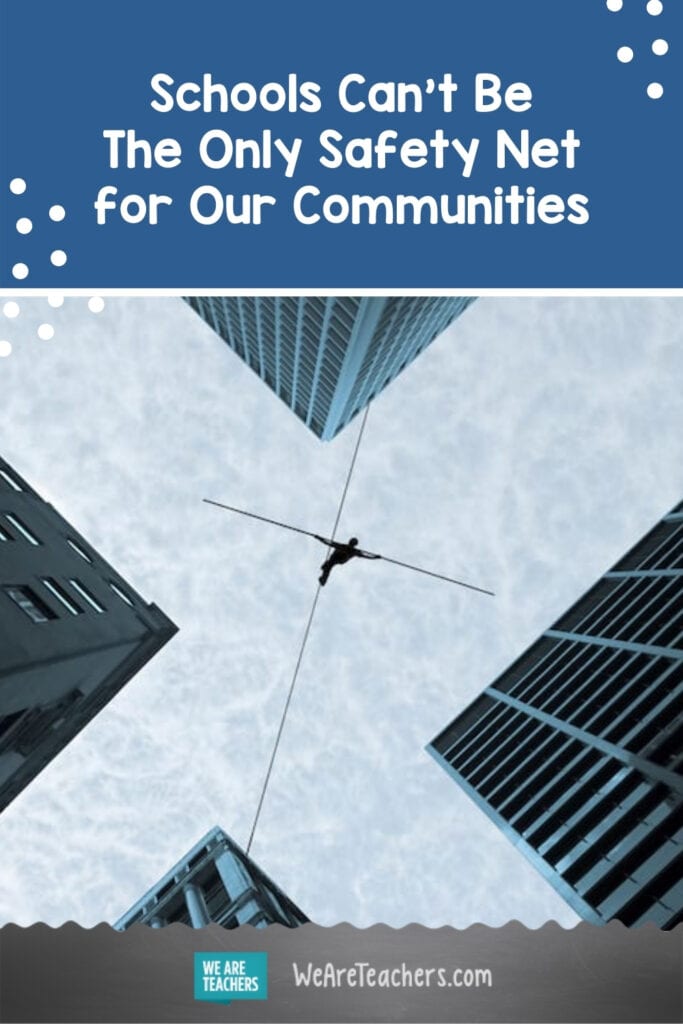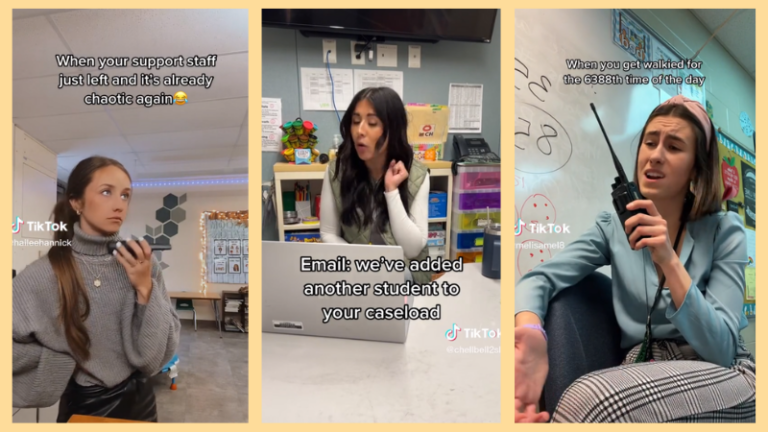My first year of teaching, I quickly realized that I wasn’t coming to school just to teach reading and writing. Every morning I packed up the student work I graded the night before and then added granola bars, tampons, cough drops, hair ties, clean socks, juice boxes, and Metrocards to my bag. I was a trained teacher, but there were so many times where I took on roles I had no training for: nurse, parent, and counselor. I desperately wanted to help my students, so I bought them winter coats and stayed after school, where I knew they’d have supervision. No class, textbook, or college course prepared me for this reality: school is the only safety net for many kids. And while I know I did my best to help my students, I also know that it wasn’t enough. School can’t be the only safety net, and yet, for many of our communities, it is.
We are asking too much of teachers, and we aren’t training them or paying them for the many roles they take on.
We can’t expect teachers to be the band-aid solution for meeting students’ most basic needs, yet we do. Teachers spend more time with students than their families during the school year. When we see a child acting out, falling asleep during class, or so hungry that they cry in class, we do whatever we can to help that child. We prioritize building strong relationships and classroom communities where students feel safe, seen, and heard. We spend money we don’t have because we care about our students and if we don’t, who will? And yet, schools evaluate us on our students’ test scores and academic achievements. So many teachers leave the profession because no matter how hard we try, we can’t fix a broken system. We can’t be the only safety net for our students. This unpaid emotional labor leaves us feeling depleted, anxious, and struggling to care for ourselves.
[contextly_auto_sidebar]
The pandemic made it even clearer that if schools close, our economy and society fall apart.
Schools as the only safety net is not a new concept, but the pandemic made it impossible to ignore how schools, without enough funding and staff, are the only reliable resource for many families and kids, alongside hospitals. Nationwide, 22 million children depend on their school for free or reduced-price lunches. The federal government spends $19 billion a year subsidizing school meals. The National School Lunch Program is the second-biggest anti-hunger program after food stamps. Working parents rely on schools and school buses for childcare and transportation so they can go to work knowing that teachers safely supervise their kids. School is the only place where the 1.5 million-plus homeless students have access to basic health care services. I don’t think that our society is going to change so much that schools stop being the primary safety net. Now that schools are getting $129 billion dollars in COVID relief funds, I do think there are steps we can take to widen the safety net within schools. Here’s how.
Prioritize student mental health and well-being. Use federal funds to hire more school nurses, social workers, and psychiatrists, teacher aides, and other support staff.
Teachers take on these roles, not because they should, but because there is no one else. Only 40 percent of schools budget for a part-time nurse and 25 percent of schools have no nurse at all, according to the National Association of School Nurses. Schools need more full-time physical and mental healthcare providers to support students. It’s going to be really hard to “catch kids up” if they are experiencing untreated trauma and PTSD. We can’t pretend that the past year didn’t happen and return to “normal.” Our kids have been through a lot and when they come back to school, we have to talk about it and support them. Only when we meet their basic needs, can learning take place.
Train teachers so they have the tools and resources they need to support their students’ mental health and well-being, and don’t ask teachers to compromise their own health.
We all know to put our own oxygen mask on first, but it’s really hard to care for yourself when you are the safety net for hundreds of children. That’s a teacher’s reality. We need to prioritize teachers’ health. Let’s normalize taking mental health days and give teachers access to free counseling and mental health care. Teachers need training on how to support traumatized students. This training needs to be ongoing so teachers have continuous support and access to resources.
Fund schools so districts can bring in tutoring, after-school programs, and summer enrichment programs.
There’s a lot of concern about learning loss, and teachers are feeling pressure to fix it or make it go away. We cannot put this responsibility all on teachers. Districts can use federal relief funds to bring in additional staff and create programs that will help students with personalized instruction and ongoing support. This will also help working parents who need a safe place for their children to go after school and over the summer.
Schools and teachers have gone above and beyond this past year to be the safety net for families and students. From delivering learning materials and meals to parking buses with Wi-Fi so students could learn remotely, schools showed up even when they were closed. But should they? Teaching is a job. Asking teachers to be and do everything without additional compensation isn’t fair or OK. We can do better than that.
To keep up with the latest teaching trends, be sure to subscribe to our newsletter!
Plus, Teacher Unions Share Their Recommendations for Back to School.


